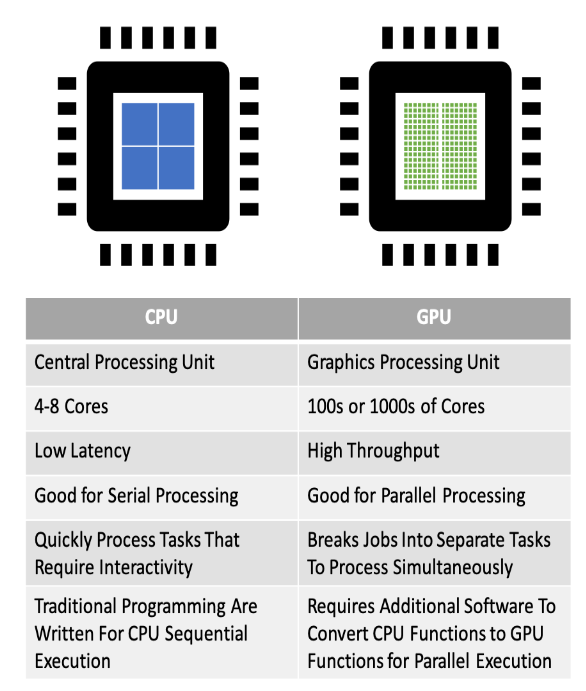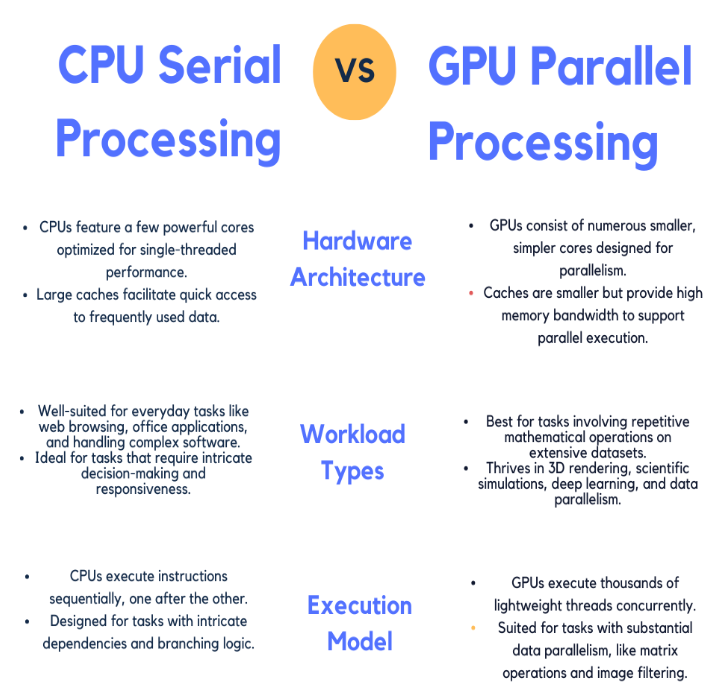General-Purpose Computing on Graphics Processing Units (GPGPUs) and the Power of Parallel Processing
Research Team
- Resource center
- Published:
- Resource center
- Published:
General-Purpose computing on Graphics Processing Units (GPGPUs) leverages the immense parallel processing power of Graphical Processing Units(GPUs) to perform select functions that are traditionally suited to Central Processing Units(CPUs) like non-graphical computations thus providing significant speedup and performance improvements for various applications.
In the realm of High-Performance Computing(HPC) which is the use of clusters of powerful processors, working in parallel, to process massive multi-dimensional datasets (big data) and solve complex problems, Graphics Processing Units (GPUs) have emerged as a game-changer. Traditionally designed for rendering graphics in video games, GPUs have evolved into versatile tools for general-purpose computing. A general-purpose computer is a description of a computer capable of performing many different tasks rather than a specific one like a special-purpose computer thanks to their remarkable serial processing capabilities. This blog post will explore the concept of general-purpose computing on GPUs, highlighting the role of parallel processing and drawing comparisons between CPU serial processing and GPU parallel processing.

I. General-Purpose Computing on GPUs:
GPU Fundamentals: GPUs are specialized hardware components initially created to handle graphical computations. Unlike Central Processing Units (CPUs), which excel in sequential, single-threaded tasks, GPUs are engineered to manage a multitude of parallel tasks concurrently.
Parallel Processing: The essence of GPU computing lies in parallel processing. This technique involves breaking complex tasks into smaller, independent subtasks and executing them simultaneously. The GPU’s architecture lends itself exceptionally well to this parallelism, making it ideal for tasks that involve massive data manipulation, such as scientific simulations, image processing, and machine learning.
Programming Models: To harness the immense parallel processing capabilities of GPUs, developers typically use programming languages like CUDA (Compute Unified Device Architecture) for NVIDIA GPUs or OpenCL, which is more vendor-agnostic. These programming models enable developers to write code that takes full advantage of the GPU’s parallelism.
II. CPU Serial Processing vs. GPU Parallel Processing:
The CPU is great for serial processing where a decision is based on a result from a previous event or a complex series of events. According to renowned scientist and AI pioneer Marvin Minsky in this way the CPU very much resembles the prefrontal cortex (PFC) of a human brain with extremely low latency. GPU on the other hand resembles most other parts of the human brain and it can offer extremely high throughput by making use of parallel processing. Author Mihaly Csikszentmihalyi in his book Creativity: Flow and the Psychology of Discovery and Invention has drawn the comparison between a computer processor and a human brain perfectly in the following quote “The distinction between serial and parallel processing of information may also explain what happens during incubation. In a serial system like that of an old-fashioned calculator, a complex numerical problem must be solved in a sequence, one step at a time. In a parallel system such as in advanced computer software, a problem is broken up into its component steps, the partial computations are carried out simultaneously, and then these are reconstituted into a single final solution. Something similar to parallel processing may be taking place when the elements of a problem are said to be incubating. When we think consciously about an issue, our previous training and the effort to arrive at a solution push our ideas in a linear direction, usually along predictable or familiar lines. But intentionality does not work in the subconscious. Free from rational direction, ideas can combine and pursue each other every which way. Because of this freedom, original connections that would be at first rejected by the rational mind have a chance to become established.”

III. Real-World Applications:
Scientific Computing:
-GPUs accelerate simulations in fields such as physics, chemistry, and climate modeling.
-They empower researchers to process massive datasets more swiftly, facilitating quicker insights.
Machine Learning:
-GPUs play a pivotal role in training and deploying neural networks.
-Reduced training times make deep learning more efficient and accessible.
Graphics and Gaming:
-GPUs continue to drive immersive gaming experiences.
-Real-time rendering and physics simulations heavily rely on GPU parallelism.
The adoption of GPUs for general-purpose computing has ushered in a new era of high-performance computing. By capitalizing on parallel processing, GPUs have made significant contributions to scientific research, machine learning, and interactive entertainment. Understanding the distinction between CPU serial processing and GPU parallel processing is crucial for selecting the appropriate hardware for specific tasks, ensuring optimal performance, and navigating the ever-evolving landscape of computing.


